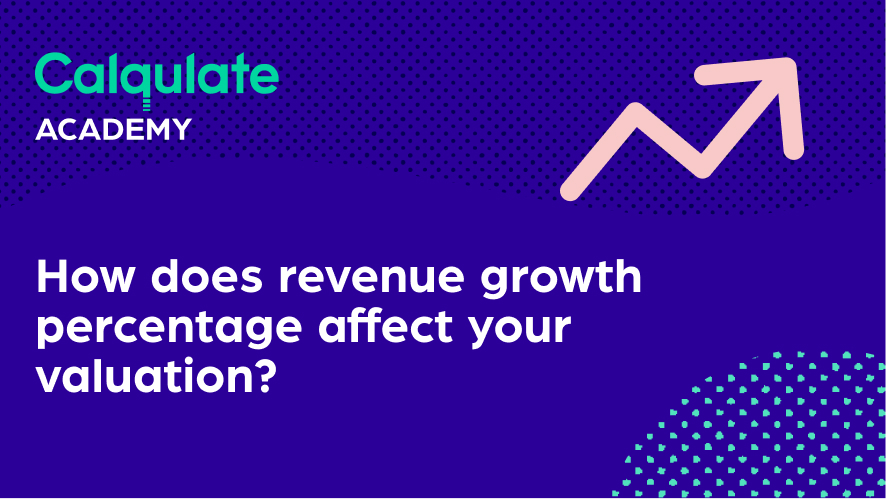According to serial entrepreneur and investor, David Cummings, not all revenue is created equally.
Still...assuming all things equal, SaaS companies with a higher growth percentage are more valuable than SaaS companies with a lower growth percentage. One SaaS company might be worth 15 times more due to a high growth rate and high net retention rate compared to the next one with higher annual recurring revenue but has a low growth rate and high churn.
Let’s look into the elements of SaaS valuations in different funding rounds.
What goes into a SaaS valuation?
To understand how your metrics affect your valuation, let’s start with what typically goes into a SaaS valuation. The five key metrics to look into are:
-
- Monthly Recurring Revenue (MRR)
The total monthly amount of your subscriptions.
- Monthly Recurring Revenue (MRR)
-
- Annual Recurring Revenue (ARR)
The total of predictable revenue from subscriptions per calendar year. Multiply your average MRR by 12 to calculate your ARR.
- Annual Recurring Revenue (ARR)
-
- Growth percentage
Your growth rate is the most important metric in your valuation. It’s the main thing investors will be looking for in your Series A or B funding.
- Growth percentage
-
- Net Revenue Retention rate
Net revenue retention, also known as net renewal rate, is used as a quality indicator of your product. This metric shows how revenue would change if there are no new customers. For example, if the revenue you gain from customers returning or upgrading is enough to cover the loss from customers canceling or downgrading without any new sales, it means that you have a product that is good enough to sell itself.
- Net Revenue Retention rate
-
- Gross margin
The money left after the cost of sales are taken out. Typically, SaaS company gross margins vary dramatically between 60% to over 90%.
- Gross margin
How do I value my company?
Valuation is a critical number to get right to manage everyone’s expectations and to close a funding round. But the process of getting there is often unclear due to the lack of objective data and the unpredictability of the market. You may even need to use more than one method to calculate your valuation – there is no one-size-fits-all formula. Let’s go through various examples and funding phases.
The best way to start is to determine the funding phase you are in. One thing’s for sure: It doesn’t matter which phase you’re in, your growth rate is going to determine your valuation.
Let’s take a look:
Seed round
You don’t yet have a strong proven track record. You’re still an early-stage startup and the capital raised will be used to fuel things like market research and product development. The main correlation is growth, and this can mean both user-based growth and revenue growth. Some of the key factors that investors will look into are:-
-
-
- Company traction
- Team expertise
- Prototype or MVP quality
- Market opportunity - Total available market (TAM), market share, market value, international expansion
-
-
Also in this phase, your growth rate matters. It gives investors an idea about the potential of your business. Therefore, your key metrics for valuation are:
-
-
-
- Rapidly growing user base
- MRR
- Growth rate
-
-
Read more: Seed round: How does revenue growth percentage affect your valuation? In this article, we will show you examples of how your growth rate affects your valuation for seed funding.
Series A
You have developed a track record with an established user base and other key performance metrics, you know you have a great product, and you’re ready to scale. By now, you could be generating an MRR of $50,000 - $100,000.
In this stage, investors are not just looking for great ideas. They are looking for proven ideas that can be turned into a successful business. While profitability doesn’t matter as much yet, the decision to invest becomes more quantitative and metrics-driven as compared to the seed phase.
In this phase, your key metrics for valuations are:
-
-
- Annual recurring revenue
- Growth rate
- Net retention revenue
- Customer Acquisition Cost (CAC)
- Customer Lifetime Value (LTV)
-
While the data for your CAC and LTV may not be 100% stable yet, they will begin to play a role in the valuation of your business in this round.
Read more: Series A: How does revenue growth percentage affect your valuation? In this article, we will show you examples of how your growth rate affects your valuation for Series A.
Series B
By the time you reach this stage, it means that you are already building a winning product and are bulking up on business development. Your company is well established and your valuation will reflect that. You would be making an MRR of at least $100,000.
When it comes to investing in your company, profitability matters. Unlike the previous two rounds, you will also require a more complicated formula to calculate your valuation.
In this phase, your key metrics for valuations are:
-
-
- Annual recurring revenue
- Growth rate
- Net retention revenue
- Gross margin
- Customer acquisition cost (CAC)
- CAC payback period
- Customer Lifetime Value (LTV)
- Market sentiment - the overall attitude of investors toward a particular market
-
Read more: Series B: How does revenue growth percentage affect your valuation? In this article, we will show you examples of how your growth rate affects your valuation for Series B.
Conclusion:
There are many factors that need to be taken into account when calculating a valuation. You would need to add other variables that affect your metrics to make it more complete. And the formula for your valuation can vary depending on the current funding stage of your business.
But before you start stressing yourself out, start by determining the funding phase you are in. The one metric that will always matter most, though – your growth rate.
Key takeaway:
There are various ways to calculate your valuation. But your growth rate is going to dictate it.
Happy Calqulating!

